
Apocrita is a suborder of insects in the order Hymenoptera. It includes wasps, bees, and ants, and consists of many families. It contains the most advanced hymenopterans and is distinguished from Symphyta by the narrow "waist" (petiole) formed between the first two segments of the actual abdomen; the first abdominal segment is fused to the thorax, and is called the propodeum. Therefore, it is general practice, when discussing the body of an apocritan in a technical sense, to refer to the mesosoma and metasoma rather than the "thorax" and "abdomen", respectively. The evolution of a constricted waist was an important adaption for the parasitoid lifestyle of the ancestral apocritan, allowing more maneuverability of the female's ovipositor. The ovipositor either extends freely or is retracted, and may be developed into a stinger for both defense and paralyzing prey. Larvae are legless and blind, and either feed inside a host or in a nest cell provisioned by their mothers.
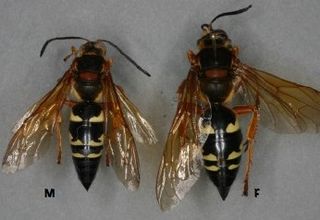
Sphecius speciosus, the eastern cicada-killer wasp, is a large, solitary digger wasp species in the family Bembicidae. They are so named because they hunt cicadas and provision their nests with them. Cicada killers exert a measure of natural control on cicada populations, and as such, they may directly benefit the deciduous trees upon which the cicadas feed. Sometimes, they are erroneously called sand hornets, despite not truly being hornets, which belong to the family Vespidae.
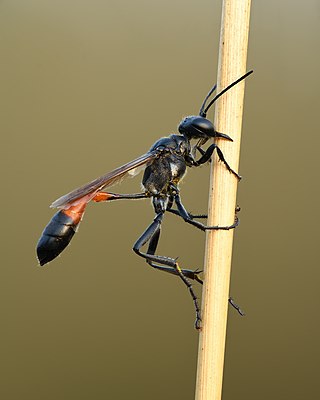
The Sphecidae are a cosmopolitan family of wasps of the suborder Apocrita that includes sand wasps, mud daubers, and other thread-waisted wasps.

The European beewolf, also known as the bee-killer wasp or the bee-eating philanthus, is a solitary wasp that lives in the Western Palearctic and Afrotropics. Although the adults of the species are herbivores, the species derives its name from the behaviour of the inseminated females, who hunt Western honey bees. The female places several of its paralysed prey together with an egg in a small underground chamber, to serve as food for the wasp larvae. All members of the genus Philanthus hunt various species of bees, but P. triangulum is apparently the only one that specialises in Western honey bees.

The Bembicidae comprise a large subfamily of apoid wasps that includes over 80 genera and over 1800 species which have a worldwide distribution. They excavate nests in the soil, frequently in sandy soils, and store insects of several orders, for example Diptera, Orthoptera, Hemiptera, Lepidoptera and Odonata in the burrows. Some species are kleptoparasites of other Bembicidae. The different subgroups of Bembicidae are each quite distinctive, and rather well-defined, with clear morphological and behavioral differences between them.

Bembix rostrata is a species of sand wasp native to Central Europe. The genus Bembix - of which B. rostrata is among the most distinctive species - has over 340 species worldwide and is found mostly in warm regions with open, sandy soils; Australia and Africa have a particularly rich variety of species.
The Stizina is a subtribe of small to large-sized sand wasps in the tribe Bembicini. The subtribe is distinguished primarily by features of wing venation. Members of the genus Stizus are large, and superficially resemble cicada-killer wasps, and members of the genus Stizoides are cleptoparasites in the nests of other Crabronids.
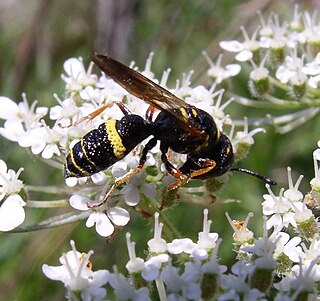
Philanthus gibbosus, the hump-backed beewolf, is a species of bee-hunting wasp and is the most common and widespread member of the genus in North America. P. gibbosus is of the order Hymenoptera and the genus Philanthus. It is native to the Midwestern United States and the western Appalachians. P. gibbosus are often observed to visit flowers and other plants in search of insect prey to feed their young. The prey that P. gibbosus catches is then coated in a layer of pollen and fed to the young wasps.

A wasp is any insect of the narrow-waisted suborder Apocrita of the order Hymenoptera which is neither a bee nor an ant; this excludes the broad-waisted sawflies (Symphyta), which look somewhat like wasps, but are in a separate suborder. The wasps do not constitute a clade, a complete natural group with a single ancestor, as bees and ants are deeply nested within the wasps, having evolved from wasp ancestors. Wasps that are members of the clade Aculeata can sting their prey.
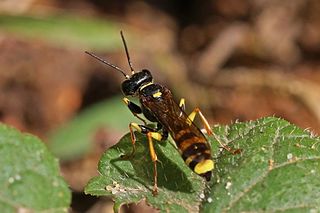
Mellinus arvensis, the field digger wasp, is a species of solitary wasp. The wasp can commonly be found from July to late September or October in sandy places. In hard soil however the female will often try to steal a nest from another member of the same species. The female is larger than the male. The wasps' nests are underground in sandy burrows with flies for their offspring to eat. The species is yellow and black like many wasp species, but they have a more narrow waist. This species is the most dominant immediately following forest fires.
Microstigmus, or the thin-waisted social wasps, is a small genus wasp in the family Pemphredonidae. This genus is found in the Neotropical realm from Central to South America. They build nests and live in colonies ranging in size from 1 to 18 members. Microstigmus is widely considered to be the only true eusocial species of apoid wasp.

Sphecius grandis, also called the western cicada killer, is a species of cicada killer wasp (Sphecius). The western species shares the same nesting biology as its fellow species, the eastern cicada killer. S. grandis, like all other species of the genus Sphecius, mainly provides cicadas for its offspring. It forms nest aggregations and mates and broods once in a year, in July and early August. The wasp is on average 3 cm (1 in) to 5 cm (2 in) in length and is amber-yellow with yellow rings on its abdomen.
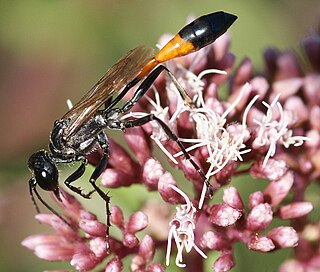
Ammophila sabulosa, the red-banded sand wasp, is a species of the subfamily Ammophilinae of the solitary hunting wasp family Sphecidae, also called digger wasps. Found across Eurasia, the parasitoid wasp is notable for the mass provisioning behaviour of the females, hunting caterpillars mainly on sunny days, paralysing them with a sting, and burying them in a burrow with a single egg. The species is also remarkable for the extent to which females parasitise their own species, either stealing prey from nests of other females to provision their own nests, or in brood parasitism, removing the other female's egg and laying one of her own instead.
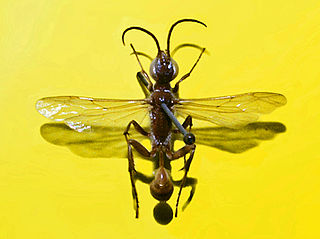
Chalybion flebile is a species of mud dauber wasps belonging to the family Sphecidae.

Crabro cribrarius, common name slender bodied digger wasp, is a species of wasp of the family Crabronidae.
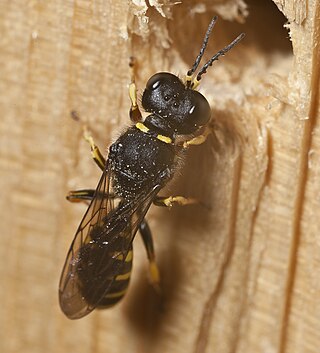
Ectemnius is a genus of wasps in the family Crabronidae. 188 species are known. The genus is found around the world but Australia has only two species.
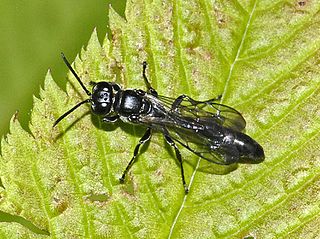
Trypoxylon is a genus of wasps in the family Crabronidae. All Trypoxylon species that have been studied so far are active hunters of spiders, which they paralyse with a venomous sting, to provide as food to their developing larvae. Depending on the species, they will either construct their own nest from mud or find cavities that already exist. These cavities can range from keyholes to nail holes to previously abandoned nests, and are generally sealed with mud to create cells for their larvae.

Tachytes etruscus is a predatory, solitary wasp belonging to the family Crabronidae. The species was first described by Pietro Rossi in 1790.

Pison spinolae, commonly known as mason wasp, is a solitary wasp of the family Crabronidae, native to Australia and found throughout New Zealand where it is an introduced species.
Trypoxylon lactitarse is a species of square-headed wasp in the family Crabronidae. It is found in North, Central, and South America, and said to range from Canada to Argentina. These are fairly common harmless solitary wasps, although as with others of this same genus, the adult males can be observed to guard the nests. This species is well-characterised as nesting in pre-existing cavities which has facilitated ecological studies, as females can be easily attracted to nest in human-made trap-nests. Females construct a linear series of cells that are subdivided by mud partitions. In the south of range, nesting activity has been recorded to occur throughout the year, although may be more common in certain months. They can begin construction of their nests with a layer of mud, followed by the formation of a linear series of 6-8 cells.

















